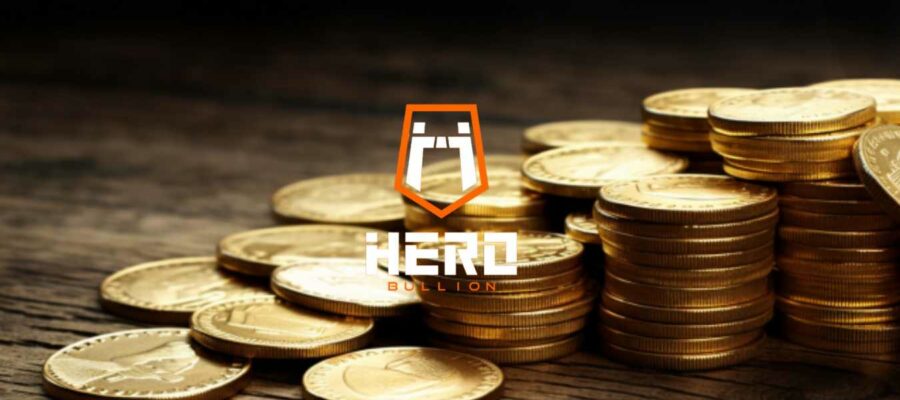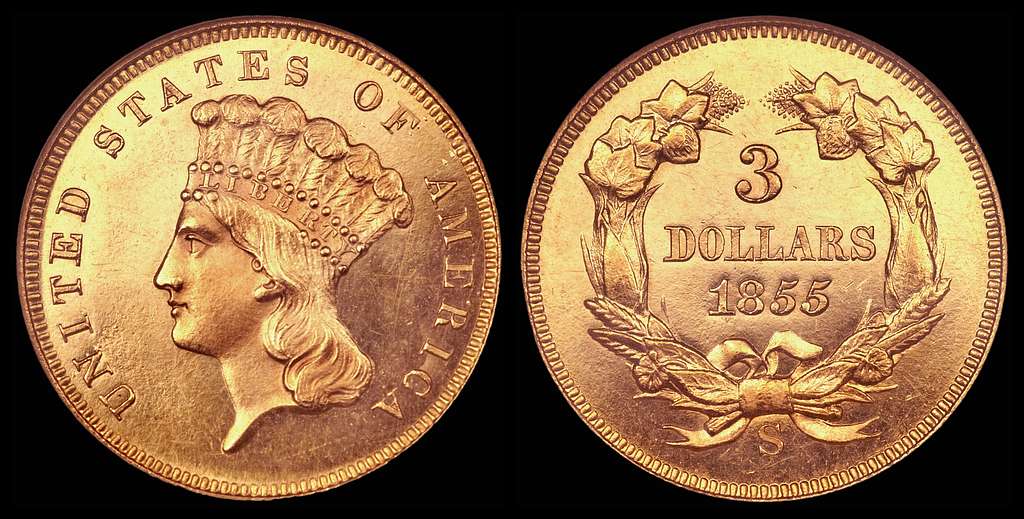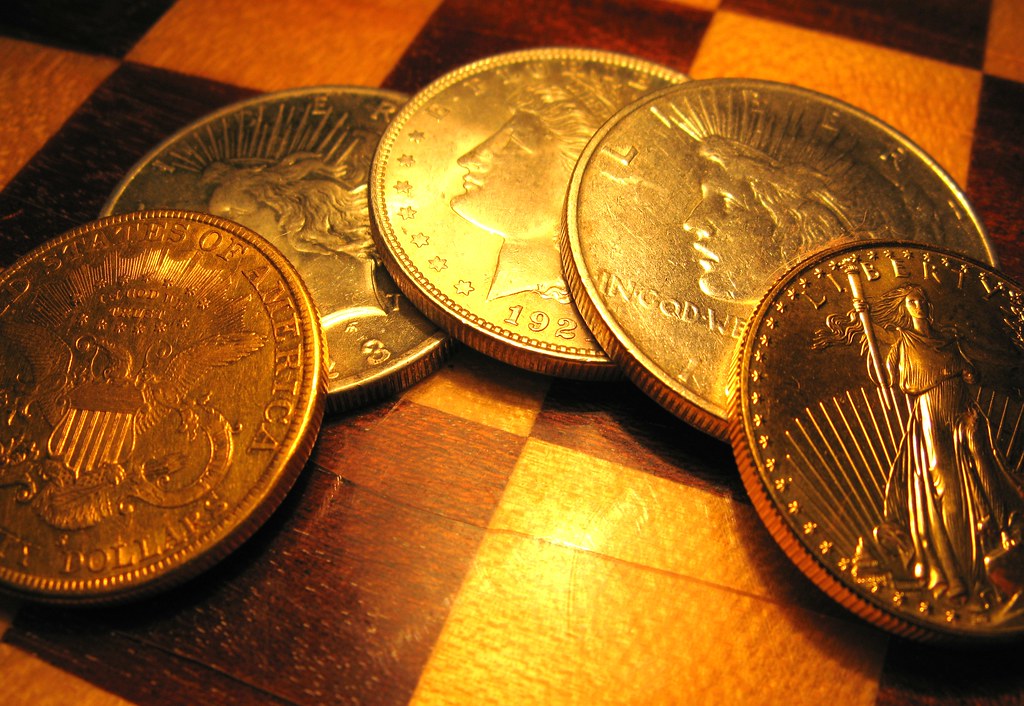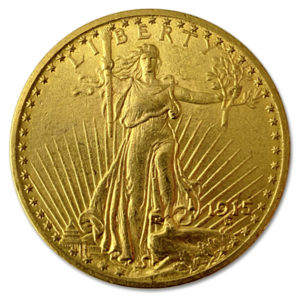3 Dollar Gold Coin

Modern gold bullion coins are important investment and collectable items. But there was a period in American history when gold and silver coins were actually used as currency. While inflation to the price of gold has made it foolish to trade modern gold coins for most goods and services, this wasn’t always the case. The 3 dollar gold coin is a good example of this trend. In fact, the coin we’re discussing in today’s guide was even used by stamp collectors to buy full collections of 3 cent American stamps.
How much is a 3 dollar gold coin worth? Are they popular among collectors? We’re answering all of your questions about buying and selling 3 dollar gold coins below.
Historical Background
A Congressional Act in 1853 authorized the production of a three-dollar piece struck with .90 fine gold bullion. As we’ll discuss below, one of the reasons that experts theorize the coin was created was to facilitate the easier purchase of large stamp collections. Nevertheless, the coin was not a huge success and saw minimal use as actual currency. Traders on the West Coast of the country used it extensively, but this is mostly due to the fact that gold and silver were employed as currency more than traditional paper money.
Unique Denomination
If you’ve studied American circulation gold coins, the unique denomination of the 3 dollar gold coin should be surprising. Historians have given quite a bit of attention to this coin because of its strange denomination. While 1, 5, 10, 20, and 50 dollar gold coins have been commonly minted throughout the history of the United States, we only ever saw one 3 dollar gold coin.

The number ‘3’ appears infrequently in United States coinage. This is strange, considering that splitting sums by three would be simpler if we had access to denominations divisible by the number. The 3 dollar gold coin was authorized just two years after the three-cent piece was minted by the U.S. Mint. It’s no coincidence that the 3 dollar gold coin is one-hundred times as valuable as the three-cent piece that preceded it. We’ll take a closer look at this relationship below.
Relationship with Stamp Collecting
One of the leading theories for the strange denomination of the 3 dollar gold coin is that its purpose was to encourage the purchase of larger stamp collections. Each stamp produced by the United States cost 5-10 cents until 1851, when the cost was lowered to three cents. That same year, the U.S. government released the three-cent piece. And three years later, they came out with the subject of today’s blog – the 3 dollar gold coin.
The coin could be used to purchase 100 of the new 3-cent stamps, a nice, round number that might appeal to collectors who wanted to complete their stamp portfolio with one large purchase. While it’s not clear that this was the main reason why the 3 dollar gold coin was minted, we find it hard to believe that the convenient purchase of stamps wasn’t a major contributor to the decision to release this unique bullion currency piece.
Rarity Due to Mintage Numbers
Compared to most modern coins, the 3 dollar gold coin offers exceptionally low mintage figures. In the first year of its release, just over 100,000 of the coins were released to the public. Due to their lack of success on the market, mintage numbers decreased in subsequent years. There’s also one coin in the series that is considered so rare that we’ve only ever seen one up for auction. We’ll dive into the history of the incredibly rare 1870 3 dollar gold coin and its value later in this guide.
But collectors should know that several mintage years for the 3 dollar gold coin offer extremely low mintage numbers. For numismatic investors, this means an exceptional investment opportunity unmatched by most modern products from the U.S. Mint.
Design and Symbolism
Collectors tend to appreciate the intricate design and artistry decorating 3 dollar gold coins. The obverse of the coin remained static throughout the piece’s entire lifespan. It features Lady Liberty, a classic American symbol, dressed as a Native American princess. For many collectors, the coin’s obverse design expertly merges two different aspects of American history and culture. The rigid outer edge of the coin adds a nice texture, and the level of intricacy included on Liberty’s portrait is unprecedented.
Two reverse designs exist for the 3 dollar gold coin. Both designs were produced by mint artist James B. Longacre. In 1854, he created the “small dollars” reverse-side design. It features the denomination (3 dollars) with small writing for the word “dollars.” Surrounding the denomination is a wreath, while the mint mark decorates the bottom of the coin. In 1855, he revised the design to include a larger, cleaner inscription of the word “dollars.” This design persisted for the entire mintage run of the 3 dollar gold coin.
Intricate Artistry
For its time period, the level of intricacy and artistry on the 3 dollar gold coin was truly unprecedented. Even today, investors enjoy the look and feel of a genuine 3 dollar piece. Even the inscription “liberty” on Lady Liberty’s headband is rendered in exceptionally readable detail. On the reverse, the flowers and various plants decorating the wreath are beautiful and hold up well, even over 100 years after the coin entered circulation.
Liberty Symbolism
Lady Liberty is a hallmark of American coinage. She appears here in her classic beauty, her hair flowing and falling into loose curls at her shoulders. She also wears a Native American headdress, adding a new layer of symbolism to this storied coin.
Native American Imagery
The inclusion of Native American imagery is another classic aspect of early U.S. coinage. Here, James B. Longacre has managed to combine both the quintessentially American Liberty with an homage to our own country’s Native American heritage and culture. This unique combination of symbols helps to make the 3 dollar gold coin an enduring American icon of early American coinage.

Small Size Advantage
For collectors at the time, the 3 dollar gold coin served an important and specific purpose. Because of its divisibility by three cents, the coin could be used to purchase 100 stamps at one time without needing to be broken into smaller denominations. By purchasing a 3 dollar gold coin, stamp collectors could complete an entire 100-stamp collection in one go.
Today, the smaller size also provides a clear advantage for modern collectors. In addition to being more liquid than larger gold coins, the limited gold content offered by this smaller denomination means that you don’t have to break the bank to afford the increased premiums associated with numismatic value. In other words, you can secure a small 3 dollar gold coin and stack pure gold bullion for cheaper than some other gold products.
Collectible Value
How valuable is the 3 dollar gold coin? We’ll address four factors behind its high collectable value below: limited survival numbers, numismatic interest, rarity, and notable auction records for especially rare 3 dollar gold coins.
Limited Surviving Coins
Like we explained toward the beginning of this guide, only around 100,000 3 dollar gold coins were produced in its initial 1954 minting run. In the years that followed, production was sporadic but never reached the heights of original mintage figures. In some years, only a very limited number of these coins were ever made. And in one year, only a single coin is known to have survived with the San Francisco (S) mint mark.
Limited surviving specimens help to make this coin one of the most coveted collectors items on the bullion market. As decades pass, the number of near-mint condition 3 dollar gold coins will continue to fall, making them even more valuable to numismatic American coin collectors.
Numismatic Enthusiasts
These coins contain only .1451 troy ounces of pure gold. While this is definitely nothing to sneeze at, it does mean that this coin contains markedly less gold than some of the gold bullion coins we sell at Hero Bullion. Because of this, consumers who invest in 3 dollar gold coins are generally numismatic enthusiasts. Numismatic collectors are more interested in coins with historical or cultural value than in pure bullion pieces. The Saint Gaudens Double Eagle is one of the most popular old American coins and demonstrates the importance of numismatics to the modern bullion portfolio.

For numismatic enthusiasts, it’s hard to beat the 3 dollar gold coin. In addition to offering beautiful fine gold bullion and brilliant obverse/reverse designs, the piece represents a fascinating and un-replicated moment in American coinage history. Even theories about the real reason why these strange coins were minted helps to bolster their place in a numismatic coin portfolio.
Rarity Grading Scale
Because of their age and limited survival rates, 3 dollar gold coins are worth quite a bit more money if they’re in near-perfect condition. Very few high grade three-dollar pieces exist. Even coins in moderate condition are still relatively rare, so they’re worth hanging onto. If you have a coin from one of the extremely low mintage years, it might be worth several thousand dollars – even in below-average grade.
Auction Records
Only one specimen of the 1870-S 3 dollar gold coin is known to exist. In 2023, the coin broke records for this series by selling for $5.52 million USD in a Heritage Auction. In future sales, the coin will likely score even more cash at auction, considering that it still remains the only coin in the entire world with its year and mint mark.
Price Appreciation Trends
3 dollar gold coins offer solid price appreciation trends. Over time, these rare coins tend to become more valuable. Each year, fewer and fewer of them are available on the open market. Because of their .90 gold purity, the pieces also appreciate in value when the spot price of gold increases.
Whether you’re a gold stacker or a numismatic coin collector, 3 dollar gold coins have quite a bit to offer the average precious metals portfolio.
Investment and Ownership
3 dollar gold coins may be the perfect investment vehicle, especially for collectors who want to add a bit of numismatic and collectable value to their portfolios. Before you dive into the numismatic coin market, there are a few things you need to know.
Diversification Benefits
The diversification benefits offered by rare coins is impossible to ignore. If your portfolio is filled with bullion coins, then your investment’s net worth is dependent almost entirely on the spot price of gold. When gold is on a bull run, a bullion-heavy portfolio is going to become more valuable. And during times of gold price depreciation, your collection will depreciate at the same rate.
But numismatic markets aren’t entirely correlated with the value of gold. This means that they can be more difficult to predict and time, but numismatics can also become more valuable – even during bearish gold bullion markets. Adding a selection of rare currency coins to your portfolio can help you to weather periods of economic uncertainty without depending too heavily on the price of gold.
Market Demand Factors
Like we mentioned above, timing the market for numismatic coins is incredibly difficult. Even seasoned investors in bullion coins sometimes struggle to properly measure and gauge investor sentiment for rare coins like the 3 dollar gold coin. Checking coin value guides, auction results, and online marketplaces like Amazon and eBay might give you a better idea of how in-demand these coins are.
Final Thoughts: Investing in 3 Dollar Gold Coins
3 dollar gold coins are one of the hidden gems of American coinage. These coins have been traded by collectors for over one-hundred years, but even their initial release remains a bit of a mystery to numismatists and historians. Some theorize that the coins were minted almost exclusively to facilitate the purchase of large quantities of 3-cent stamps from the U.S. Postal Service.
Today, these coins offer exceptional investment value to collectors who seek to diversify and expand their precious metal holdings. Equipped with .90 gold bullion and some of the most beautiful designs to ever come out of the U.S. Mint, it’s clear why millions of collectors have fallen in love with U.S. 3 dollar gold coins.
You might also like:
About The Author
Michael Roets
Michael Roets is a writer and journalist for Hero Bullion. His work explores precious metals news, guides, and commentary.
